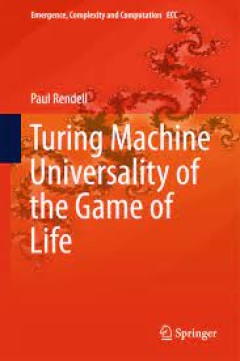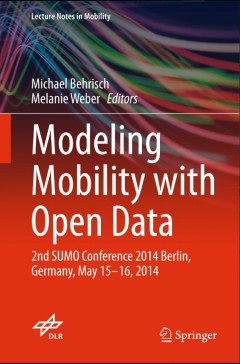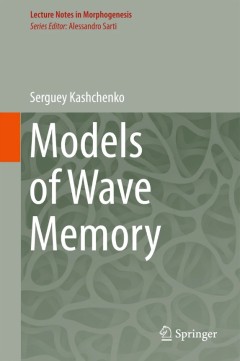Filter by

Experimental Econophysics
Experimental Econophysics describes the method of controlled human experiments, which is developed by physicists to study some problems in economics or finance, namely, stylized facts, fluctuation phenomena, herd behavior, contrarian behavior, hedge behavior, cooperation, business cycles, partial information, risk management, and stock prediction. Experimental econophysics together with empiri…
- Edition
- -
- ISBN/ISSN
- 978-3-662-44234-0
- Collation
- 40 b/w illustrations, 35 illustrations in colour
- Series Title
- -
- Call Number
- -

Turing Machine Universality of the Game of Life
This book presents a proof of universal computation in the Game of Life cellular automaton by using a Turing machine construction. It provides an introduction including background information and an extended review of the literature for Turing Machines, Counter Machines and the relevant patterns in Conway's Game of Life so that the subject matter is accessibly to non specialists. The book co…
- Edition
- -
- ISBN/ISSN
- 978-3-319-19842-2
- Collation
- XV, 177
- Series Title
- -
- Call Number
- -

Hermann Haken: From the Laser to Synergetics: A Scientific Biography of the E…
Hermann Haken (born 1927) is one of the “fathers” of the quantum-mechanical laser theory, formulated between 1962 and 1966, in strong competition with American researchers. Later on, he created Synergetics, the science of cooperation in multicomponent systems. The book concentrates on the development of his scientific work during the first thirty-five years of his career. In 1970 he a…
- Edition
- -
- ISBN/ISSN
- 978-3-319-11688-4
- Collation
- XII, 317
- Series Title
- -
- Call Number
- 621.336 KRO h

Modeling Mobility with Open Data: 2nd SUMO Conference 2014 Berlin, Germany, M…
This contributed volume contains the conference proceedings of the Simulation of Urban Mobility (SUMO) conference 2014, Berlin. The included research papers cover a wide range of topics in traffic planning and simulation, including open data, vehicular communication, e-mobility, urban mobility, multimodal traffic as well as usage approaches. The target audience primarily comprises researchers a…
- Edition
- 1
- ISBN/ISSN
- 978-3-319-36573-2
- Collation
- X
- Series Title
- Lecture Notes in Mobility
- Call Number
- -

Multiphysics Modelling and Simulation for Systems Design and Monitoring:Proce…
This book reports on the state of the art in the field of multiphysics systems. It consists of accurately reviewed contributions to the MMSSD’2014 conference, which was held from December 17 to 19, 2004 in Hammamet, Tunisia. The different chapters, covering new theories, methods and a number of case studies, provide readers with an up-to-date picture of multiphysics modeling and simulation. T…
- Edition
- 1
- ISBN/ISSN
- 978-3-319-38425-2
- Collation
- XII
- Series Title
- Applied Condition Monitoring
- Call Number
- -

Models of Wave Memory
This monograph examines in detail models of neural systems described by delay-differential equations. Each element of the medium (neuron) is an oscillator that generates, in standalone mode, short impulses also known as spikes. The book discusses models of synaptic interaction between neurons, which lead to complex oscillatory modes in the system. In addition, it presents a solution to the prob…
- Edition
- 1
- ISBN/ISSN
- 978-3-319-19865-1
- Collation
- xxviii, 239
- Series Title
- Lecture Notes in Morphogenesis
- Call Number
- -

Synchronization of Integral and Fractional Order Chaotic Systems
This book provides a general overview of several concepts of synchronization and brings together related approaches to secure communication in chaotic systems. This is achieved using a combination of analytic, algebraic, geometrical and asymptotical methods to tackle the dynamical feedback stabilization problem. In particular, differential-geometric and algebraic differential concepts reveal im…
- Edition
- -
- ISBN/ISSN
- 978-3-319-15284-4
- Collation
- XXIV, 242
- Series Title
- Understanding Complex Systems
- Call Number
- -

Towards a Theoretical Framework for Analyzing Complex Linguistic Networks
The aim of this book is to advocate and promote network models of linguistic systems that are both based on thorough mathematical models and substantiated in terms of linguistics. In this way, the book contributes first steps towards establishing a statistical network theory as a theoretical basis of linguistic network analysis the boarder of the natural sciences and the humanities. This book a…
- Edition
- 1
- ISBN/ISSN
- 978-3-662-47237-8
- Collation
- XXII, 343
- Series Title
- Understanding Complex Systems
- Call Number
- -

A Route to Chaos Using FPGAs: Volume I: Experimental Observations
The purpose of this introductory book is to couple the teaching of chaotic circuit and systems theory with the use of field programmable gate arrays (FPGAs). As such, it differs from other texts on chaos: first, it puts emphasis on combining theoretical methods, simulation tools and physical realization to help the reader gain an intuitive understanding of the properties of chaotic systems. …
- Edition
- Ed. 1
- ISBN/ISSN
- 978-3-319-18105-9
- Collation
- XXIII, 219
- Series Title
- Emergence, Complexity and Computation
- Call Number
- 004 MUT r

Interprofessional Education in Patient-Centered Medical Homes: Implications f…
This book discusses the application of complex adaptive systems theory to the design and evaluation of patient-centered medical homes (PCMHs). The three defining goals of PCMHs are to spread patient-care roles among healthcare team members, focus on disease prevention and include the patient in the healthcare team. It explains why some PCMH pilots are highly successful while others do not show …
- Edition
- -
- ISBN/ISSN
- 978-3-319-20158-0
- Collation
- -
- Series Title
- -
- Call Number
- -
 Computer Science, Information & General Works
Computer Science, Information & General Works  Philosophy & Psychology
Philosophy & Psychology  Religion
Religion  Social Sciences
Social Sciences  Language
Language  Pure Science
Pure Science  Applied Sciences
Applied Sciences  Art & Recreation
Art & Recreation  Literature
Literature  History & Geography
History & Geography